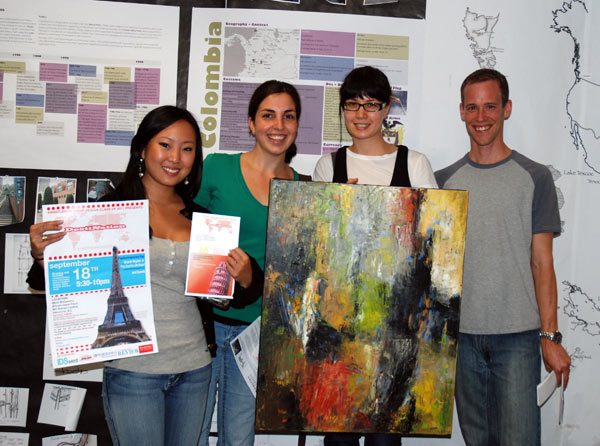Elections are in the air
February 10, 2010 by Kyle Vinoly · Leave a Comment

Voting will be open tomorrow (Thursday) from 10 a.m. until 7 p.m. so students at the Richmond and Langley campuses can cast their ballots. (Kyle Vinoly photo)
Tomorrow (Thursday) will be the final day Kwantlen students can cast their vote in this year’s Kwantlen Student Association’s general election.
“Richmond is always really busy,” said Fran Schiffner, whose company oversees elections at the different Kwantlen campuses. “I think it’s because of where it is. It’s all in one building…I think there’s more exposure.”
Shiffner said this election has seen less of a voter turnout then in previous years.
“The last few [years] we’ve run out of ballots,” said Alice Rush, who works for Schiffner. “We need to get more people out to vote.”
Both women believe mid-terms and the Olympics may be distracting students from showing up.
Voting will be open until 7 p.m. tonight (Wednesday) and tomorrow, at Richmond and Langley campuses. Voting closed Tuesdays at Cloverdale and Surrey.

Fran Schiffner and Alice Rush are on hand to make sure every vote is cast fairly. (Kyle Vinoly photo)
Depression hits youth hardest, doctors encourage youth to explore alternatives to psychotropic drugs
January 12, 2010 by Kyle Vinoly · Leave a Comment
Canadians under 20 report the higher level of depression, and people between 20 and 29 years of age have the highest levels of anxiety, according to report issued in September by the Canadian Mood Disorders Society.
The most alarming statistics to come out of the report are that 90 per cent of people who commit suicide have a diagnosable mental illness, and that suicide is the cause of death for 24 per cent of Canadians between 15 and 24 years of age, and 16 per cent of those between the ages of 20 and 29.
Women are twice as likely as men to experience depression, and although 80 per cent of people with depression respond well to treatment, 90 per cent of those with depression don’t seek treatment.
“Depression, sometimes it’s a blessing,” said Dr. Hamdy El-Rayes, director of the H.R. Mental Wellness Centre, “because it stops you in your tracks and makes you reflect on the way you’re going and what you need to do.
“Medication does not solve the underlying issues that caused the depression or anxiety.”
El-Rayes said he feels that Canadian youth should explore all options before turning to medication.
He believes that empowering those who have depression or anxiety, and encouraging them to take charge,, is the only successful way to heal someone. El-Rayes said that being younger is an advantage for people, because they have more time to work out issues and aren’t as set in their ways.
Growing up with the Internet and easy access to information has made this generation more open to new ideas, but at the same time has inundated them with too much information.
“Everything is new, and so younger people are willing to accept anything that will help them,” El-Rayes said. From what he sees in his practice, he feels that younger people ask more questions, hesitate to take something just because they’re doctor said to, and are more aware of medication side effects than previous generations were.
Canadians turn to medication more often than not. According to the Mood Disorders Society of Canada, Canadians are the largest users, on aper-capita basis, of psychiatric medications in the world. Canadians are also the secondlargest users of sedatives and the fourth-largest users of prescription narcotics in the world, according to the society. In 2006, there were 51 million prescriptions for psychiatric medications dispensed by Canadian pharmacies, a 32 per cent increase over the previous four years.
“You expect to be able to medicate yourself out of any problem,†said Paul Swingle, a Vancouver psycholo-gist, who argues that simply medicating a problem doesn’t address what caused it in the first place.
“That’s the alcoholic mentality, that you can avoid everything by getting plastered,†he said.
Swingle has seen the consequence of treating depression on the surface rather than at its source.
He has seen many women between the ages of 25 and 40 with a previously undiagnosed form of ADD known as High Frontal Alpha ADD. These women struggled in school, often couldn’t hold a job and, after becoming depressed, were put on a roster of medication to treat their depression. They went undiagnosed because the behaviour associated with the condition are talkativeness and flightiness.
“Since that fit our cultural stereotypes, these unfortunate young girls went undiagnosed,†said Swingle. “So they weren’t treated for the ADD, which created a reactive depression because of failure.â€
The perception of drugs being the answer to emotional problems has been spread effectively by pharmaceutical advertising, which is legal in the U.S and Australia. But because American programing is prevalent on Canadian television, it’s common on our airwaves. A local therapist, Cindy Trevitt, said she feels that this is the greatest threat on the mental landscape for today’s youth.
“The implicit message is don’t feel bad ever, you should feel happy always and not experience life,†said Trevitt, a Vancouver counsellor. “It takes away from our ability to experience life. If I can feel sadness to its great depths I can also feel joy to its great heights.â€
Trevitt argued that although today’s generation may be bombarded by this advertising, it is less influenced by it than previous generations.
Old news sparks new views
January 12, 2010 by Kyle Vinoly · Leave a Comment

Roy Wadia Director of Communications for the British Columbia Centre for Disease Control is confident Canada will be able to deal with the outbreak of H1N1, as it has with previous infections. (STOCK PHOTO/BCCDC)
Avian flu and the West Nile virus may have dropped off the media radar with all the attention on H1N1, but they have not dropped off the map.
“Because [avian flu is] not spread effectively between bird and human, it’s not a huge concern for most people,†said Roy Wadia, director of communications for the British Columbia Centre for Disease Control. “If it were to become of pandemic size, it could cause a catastrophic pandemic on a scale that would epically dwarf the current H1N1 pandemic.â€
“Everything is ultimately local,” said Wadia. “If it’s happening in your neck of the woods, it’s a big story,†said Wadia. “If it’s happening in another country thousands of miles away, or even two or three countries away from you, it’s not a concern.â€
Wadia, who was working in China during the original outbreak of avian flu in 2003, recalled that although it was a big concern in that area, it was of minimal concern in the West.It was not until the virus resurfaced in 2008 on Western farms and began having a direct affect on farmers and citizens that it received widespread attention. Since then, media focus has shifted again, but Wadia still sees avian flu as a huge public-health issue.
According the World Health Organization, there have been 442 documented cases of avian flu infection among people, with 262 of those cases proving fatal. Direct contact with diseased birds is believed to be the cause of most of these infections, and transfer from human to human has been rare. However, the potential for the disease to mutate or evolve and become more efficient in transferring is the largest concern for public-health officials.
West Nile virus is another infection endemic to various parts of the world. The virus first appeared in North America in 1999, but how it came to New York remains a mystery. Until then, the virus was found in Africa, Eastern Europe, parts of the Northern Mediterranean, Egypt, Israel, Romania and the Czech Republic. Upon its arrival in North America, it became the most widely spread vector-borne disease (spread by the bite of an insect or animal) on the continent, according to the BCCDC. To date, seven Canadians have reportedly contract the virus, two in B.C., two in Alberta and one each in Saskatchewan, Manitoba and Ontario. None of those people died.
A senior environmental health specialist for the BCCDC, Ken Cooper, noted that the original North American form of West Nile, designated NY99, has mutated, is virtually extinct and has been replaced by WN02, a closely related variation.
According to the BCCDC, only one in 150 people infected with the disease will respond strongly to it; others can carry it without ever knowing they had it. The centre reports that there were 4,511 cases of WNV reported in Canada between 2002 to 2008.
“There are serious side effects for those who become ill with neurological symptoms,†said Cooper an email interview. “Even those who get milder symptoms can still be quite ill and have an impact on health care and on economics.â€
The economic cost of responding to avian flu has been felt by farmers around the world, who have had to slaughter their birds, including geese, ducks and chicken, to stave possible spread of the infection. In 1997, Hong-Kong destroyed 1.4 million chickens when a portion tested positive for the infection, according to reports from CBC. In 2007, a commercial duck farm in Regina executed 50,000 birds after some of them tested positive for H7N1, a variation of avian flu that does not kill people.
“Avian flu has a strong economic impact on people who are poultry farmers and [who] work in the agriculture field,†said Wadia. “From Vancouver’s perspective it’s no big deal right now, but if you see it from the perspective of a farmer in China, or a very large poultry processor in Thailand, it’s a huge deal.â€
Wadia added he is confident the Canadian health community is well-prepared for H1N1.
Richmond students welcomed back with food, info
January 6, 2010 by Kyle Vinoly · Leave a Comment

Kwantlen alumni Cory Van Ieperen of Corycatures puts the finishing touches on a current student. (Kyle Vinoly photo)
Both new and returning students were greeted by slices of pizza and air brushed tattoos, when they walked through the doors of Kwantlen’s Richmond campus this week. The food and festivities are part of the Kwantlen Student Association’s Welcome Back Week, which gave students a chance to get familiar with the different services available this semester and get free food.
Students had to wait patiently for their pizza, which came from the Fresh Slice on Granville Street, because the location in the Lansdowne Mall was closed because of a planned power outage. Vanessa Knight, the director of student life for the KSA, hoped the event planned for Thursday at the Langley campus would go smoother. Students at the Cloverdale campus were to be treated to a pancake breakfast and guest speakers for the next month, said Knight.
Among the displays at Richmond was one from Apex Martial Arts, which is offering students 10 classes for $60, hosted at the Yyoga studio on the Richmond campus. “It’s an awesome deal for students,” said Marcy Hilario, assistant kickboxing coach and assistant kids martial arts coach at Apex. “Regularly, if you go to a martial arts studio it’s $25 for one class.”
A free drop-in session will be offered Wednesday, Jan. 13, with the 10 sessions starting the following week.
Hip-hop dancing and pilates will also be offered in the studio: for a complete schedule check the Student Health Improvement Plan’s website .

Amanda of Tattoos For Now was turning out the air brushed tattoos all day. She encouraged students to check out the web site and try out the tanning the studio offers. (Kyle Vinoly photo)

This student decided to go for something besides a panther, which the artist said was the most popular tattoo of the day.(Kyle Vinoly photo)

Students didn't seem to mind waiting for the free pizza to arrive from down town. (Kyle Vinoly photo)

There were student volunteers on hand to help guide curious students through the various booths. (Kyle Vinoly photo)

Vanessa Knight said that feeding the trade students at the Cloverdale campus is a frightening experience. (Kyle Vinoly photo)
Audio slideshow: Kwantlen’s band of brass
November 5, 2009 by Kyle Vinoly · Leave a Comment
The auditorium of Kwantlen’s Langley campus was filled with rich and lively sound of the schools’ brass ensemble yesterday afternoon. The group, comprised of students from the music program, will be preforming mid-week until the second week of December.
Tom Shorthouse, the jazz and brass ensemble instructor, expects three or four more shows this semester but is hoping the group will be able to preform six or seven shows in the spring semester.
“Getting going in September, no matter how experienced the group, just takes a little bit of time to get the wheels churning,” said  Shorthouse. “By the time we hit January, Febuary things are really moving along.”
KSA collecting students’ thoughts on U-Pass
October 29, 2009 by Kyle Vinoly · 5 Comments

This week a series of U-Pass consultations wrapped up on the Richmond campus. The KSA will return to Richmond next week for another round, eventually concluding in Cloverdale and Langley. (Kyle Vinoy photo)
The Kwantlen Student Association has been touring Kwantlen campuses hosting U-Pass consultations designed to give the KSA a better idea of improvements students would like to see made to transit in order to ease their commute, and to gauge the level of support for a U-Pass.
“We want to make sure that commuting between campuses isn’t the reason students don’t take a course,” said Derek Robertson, director of external affairs.
This week’s series wrapped up yesterday at the Richmond campus, with a return scheduled for next Tuesday afternoon at 2:15 pm in room 1420. Consultations has concluded at the Surrey and Langley campuses, with consultations at Cloverdale scheduled for next week.
At each sessions students are given an 11-page survey which explores their current transit use and improvements they’d like to see Translink make to its service. Robertson said that improving the current level of transit availability and frequency for the Cloverdale and Langley campuses is crucial to the KSA accepting any form of the U-Pass. He also wants to see more recognition payed to Kwantlen by renaming the Landsdowe station on the Canada Line to include the school’s name.
Robertson does not support a $25 U-Pass being pushed by OnePassNow as he feels supporting it would mean Kwantlen students would subsidize students at other colleges, such as Emily Carr and VCC-Clark. He said that those two schools combined have roughly 10,000 students and Kwantlen has 15,000 and that difference would equal an unfair price tag for Kwantlen students. He said that Kwantlen students could hope for a pass costing between $25 to $30 without partnering with other universities.
After all the data from the consultations is complied, Robertson plans to meet with Translink and the provincial government and come to an agreement. He will be in Ottawa next month to present the data and hopes to arrange a meeting with federal transport minister John Baird.
Robertson’s goal is to hold a referendum on the U-Pass in the KSA general election this spring.
Corrections: Old news sparks new views
October 14, 2009 by Kyle Vinoly · Leave a Comment
In a recent Kwantlen Chronicle article the numbers quoted regarding H5N1, avain flu, and WN02, West Nile, were not the most recent.
According to the most recent summary released by the World Health Organization the number of people infected with H5N1, avain flu, is actually 442 confirmed cases as of late September with 262 deaths.
The West Nile Virus has seven confirmed cases in Canada, two in B.C and Alberta and one each for Saskatchewan, Manitoba and Ontario. None of those cases proved fatal and only 20 per cent of people infected will show a mild form of the illness at all.
The Canadian Centre for Disease Control does not exist, the proper source is the B.C. Centre for Disease Control. Hong-Kong, not China, slaughtered the 1 million birds. Roy Wadia, director of communications for the B.C. Centre for Disease Control, said that China didn’t acknowledge the outbreak of H5N1 until much later.
Kwantlen’s journalism program on the move to social sciences
October 8, 2009 by Kyle Vinoly · 2 Comments

Beverley Sinclair, chair of Kwantlen's Journalism program, soaks in the latest issue of the Chronicle, which as of 2011 will be based in Surrey.
As of Oct. 9, Kwantlen’s Journalism program will become part of the faculty of social sciences, leaving its long-time home in the faculty of design and communications.
“It’s really an administrative change at this point,” said Beverley Sinclair, coordinator of the journalism program. Students can expect to feel the impact of the change in the fall of 2011, when all the journalism courses will likely be moved on Kwantlen’s Surrey campus.
“The faculty of Design and Communications, which is where we have been, has been fine up until now,” said Sinclair. “We are clearly more suited to be with and aligned with [the faculty of social sciences], it’s just a way better fit.”
Sinclair said the idea to switch faculties was first discussed about a year ago.
The hope is that moving from Richmond to Surrey campus will improve access for journalism students to social science courses and vice versa. The areas of study featured in social sciences are anthropology, Asian studies, criminology, geography, history, political science, psychology and sociology.
“We want to make our third- and fourth-year courses, the academic ones, more widely available to students who can benefit from them,” said Sinclair.
Robert Adamoski, chair of the criminology department, sent an email welcoming the journalism department into his faculty. He echoed Sinclair’s hope that the shift will make programs more accessible for students in both faculties and cited the benefit of different perspectives being shared between students.
“It’s clear to me that this is a dynamic period for journalism as a profession and an academic discipline,” wrote Adamoski in the email. “[The]Â Kwantlen faculty have a good sense of the opportunities that a carefully considered, leading-edge BA program will offer.”
Sinclair said that changes will be made to the program in order for it to keep up with what’s happening in the journalism profession. More emphasis will be placed on what’s been called new media and on-line publishing, which doesn’t mean that print or photography will be neglected.
“Being able to write and do great photography and images, that will always be the mainstay of the program,” said Sinclair. “How it’s delivered is changing and so we just continue to change in the program as well.”
The program will also continue to develop strong academic journalism and mass communications studies.
Interior Design students look to stand out from the crowd.
September 17, 2009 by Kyle Vinoly · Leave a Comment

(From left to right) Third-year Interior Design students Whitney Chow, Anni Mergeran, Beatrice Muschol and Lucas Nightingale show off their advertising and an oil painting that will be featured as part of their silent auction at IDSwest.
“It’s exciting,” says Beatrice Mushill, a third-year student of Kwantlen’s Interior Design program. Mushil and 10 other members of her program will be on hand Friday night at the IDSwest Trade Show in an attempt to raise the remainder of funds needed to finance a trip abroad.
The group’s presentation, DestiNation, will be their second fundraiser for a trip Mushil describes as “a full seven to 12 days of sketching 24/7 , learning about architeture, design, culture and the differences of culture.” Though the decision about where to go hasn’t been made yet, Mushil said Spain, France or Ecuador are all being considered.
In order to get there, the group is selling tickets for IDSwest for $40, or $20 if you’re a student. The ticket covers access to the show for the evening, free hors d’oeuvres, a student project display and a live performance by musician Sharon Bryson and guests. There will also ve a silent auction of an oil painting supplied by local artist Pamela Hunt.
IDSwest was launched in 2004 and describes itself as Western Canada’s premiere design event, with over 200 exhibitors displaying different products and services to designers, industry professionals and consumers. Tonight will mark the opening of the three-and-a-half-day show, which takes place at Monk’s McQueen, 601 Stamps Landing in Vancouver.
For further information, visit their website at www.idswest.com and if you want to pick up tickets, you can email Destination_fundraiser@live.com or call Amber at 778-928-3672.


